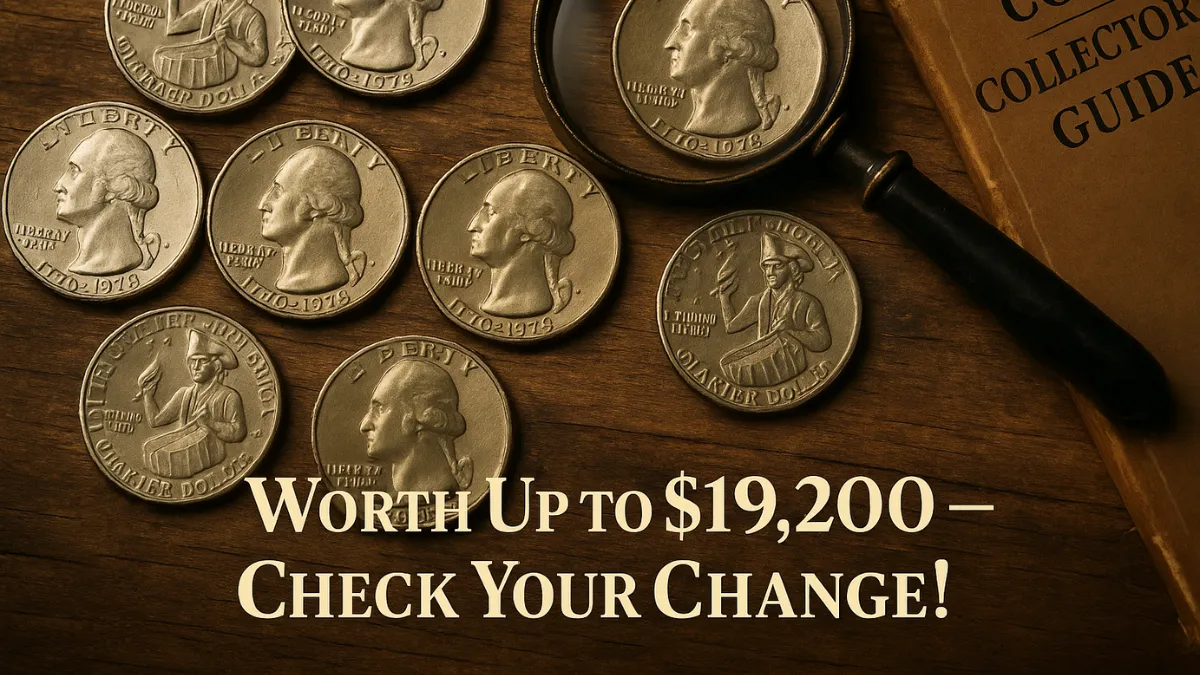When we talk about bicentennials in connection with George Washington, there are two key moments to consider. The first occurred in 1932, marking 200 years since his birth, and it’s the year his likeness was first used on a U.S. quarter.
The second is from 1976, celebrating 200 years of American independence. This event was marked with a dual-date coin release. Let’s now explore the most valuable 1976 Bicentennial Quarters worth serious money.
1976 Clad Bicentennial Quarter Regular Strike
In this section, we’re zooming in on Bicentennial coins produced specifically in 1976. Each of these coins is stamped with the years “1776 – 1976,” commemorating America’s independence from British rule and the establishment of a sovereign democratic republic. This era was shaped by prominent figures known as the Founding Fathers, seven of whom are particularly renowned for their instrumental roles in shaping the new nation.
- Metal: Type 3 Clad
- Mint Mark: None (Philadelphia)
- Grade: MS 67+
- Date of Sale: 27th March 2023
- Price: $1,821
Since American independence was secured through the Revolutionary War, this anniversary honored not just political ideology but also military achievement. Many Founding Fathers were both leaders in battle and philosophical architects of the country. George Washington stands out among them, eventually becoming the United States’ inaugural president. Interestingly, three others from this group would also go on to lead the nation.
1976-S Silver Bicentennial Quarter Business Strike
Although many statues and memorials exist in Washington’s honor, he personally opposed his image appearing on U.S. currency. He felt it echoed the kind of self-glorification associated with the British monarchy, which the new nation had just overthrown. Washington, along with Benjamin Franklin, supported the use of allegorical figures like Lady Liberty to represent national values, avoiding personal hero worship on coinage.
- Metal: Type 4 Silver
- Mint Mark: San Francisco
- Grade: MS 69
- Date of Sale: 9th June 2019
- Price: $19,200
Originally, Lady Liberty was inspired by figures from Greco-Roman mythology, but as time went on, real American women were used as models for her image. Some notable examples include Elsie Stevens for the Mercury Dime, Teresa de Francisci for the Peace Dollar, and Ann Willing Bingham for the Draped Bust coins. These living inspirations gave Lady Liberty a relatable, modern feel across generations of coinage.
Double Denomination 1976 Bicentennial Quarter Struck on a Dime
Anna Willess Williams was another woman selected to model Lady Liberty, this time for the Morgan Dollar. However, she was reluctant to have her identity revealed. In the early years, coin designs prioritized function over form and tended to be more austere. But in 1904, President Theodore Roosevelt sought to revamp U.S. currency to reflect both artistic beauty and economic value, paving the way for portraits of U.S. presidents.
- Metal: Type 3 Clad
- Mint Mark: None (Philadelphia)
- Error: Bicentennial Quarter Struck on a Dime
- Grade: MS 62
- Date of Sale: 15th December 2020
- Price: $9,200
Lincoln became the first president to appear on a coin in 1909, commemorating the centennial of his birth. This started a new tradition in American numismatics. Subsequently, Washington was featured on the quarter in 1932, the bicentennial of his birth. This design has endured to the present day. The bicentennial in 1976 was distinct, kicking off planning a decade earlier in 1966 with events and special coinage lined up.
1976-S Clad Proof Deep Cameo Bicentennial Quarter
To mark two centuries of freedom, the U.S. Mint rolled out commemorative coins in the country’s most used denominations: the quarter, half dollar, and dollar. These coins were issued both for everyday use and as collectors’ items, with special Bicentennial Sets available. Proof sets included all six denominations in superior finish, intended more for display than spending.
- Metal: Type 3 Clad Proof
- Mint Mark: San Francisco
- Grade: PR 70 DCAM
- Date of Sale: 8th July 2010
- Price: $920
The silver versions contained 90% silver and 10% copper, while circulating coins had their standard clad composition of 91.67% copper and 8.33% nickel. These clad coins featured a core of solid copper and were plated in a copper-nickel alloy that gave them the luster of silver but with reduced production costs. This blend allowed the Mint to produce eye-catching coins affordably, benefiting their financial operations.
1976-S Clad Proof Bicentennial Quarter
Understanding the concept of seigniorage helps make sense of the Mint’s coin composition decisions. This refers to the profit made from producing currency, calculated by subtracting manufacturing costs from face value. For example, if a $1 coin costs 90 cents to produce, the remaining 10 cents becomes profit for the Mint, representing revenue collected as a form of indirect taxation.
- Metal: Type 3 Clad Proof
- Mint Mark: San Francisco
- Grade: PR 69
- Date of Sale: 3rd November 2010
- Price: $6,038
This margin is essentially seigniorage and plays a major role in funding Mint operations. To increase this margin, the U.S. Mint has consistently looked for more efficient, cost-effective production methods. Digital technology now streamlines the entire coin creation process, greatly reducing overhead costs. Meanwhile, premium sets like proofs and commemorative coins provide a lucrative supplemental revenue stream.
1976-S Silver Proof Deep Cameo Bicentennial Quarter
Several key events throughout U.S. history have impacted what metals are used in coins. From the Gold Rush of the 1850s to the Coin Shortage of the 1960s, and the fluctuating market prices for silver and copper, all these events led to changes in coin materials. During war periods, even nickel was reallocated for military use. The Bicentennial series was released during such a transitional phase in coin composition.
- Metal: Type 4 Silver Proof
- Mint Mark: San Francisco
- Grade: PR 70 DCAM
- Date of Sale: 29th November 2007
- Price: $2,760
After the 1960s shortage, silver content in circulating coins was steadily reduced. By 1965, quarters went from being 90% silver to just 40%, and by 1971, they used copper cores with a copper-nickel shell. This change made coins more economical to produce and kept them in public circulation. Silver coins, while still struck, became collector-focused items and rarely changed hands in day-to-day transactions.
1976-S Silver Proof Bicentennial Quarter
Modern circulating coins adopted a layered metal approach using a mostly copper base with a copper-nickel coating. However, some special Bicentennial Quarters retained the traditional 90% silver content, adding intrinsic value due to their melt potential. Melt value is calculated based on the current market rate for silver and the actual silver weight present in the coin.
- Metal: Type 4 Silver Proof
- Mint Mark: San Francisco
- Grade: PR 25
- Date of Sale: 26th March 2019
- Price: $13,500
Though the coins bear the 1776–1976 date, they were actually minted during 1975 and 1976. There are no Bicentennial coins with a 1975 date. The obverse side remained consistent with prior coins—featuring Washington on the quarter, Kennedy on the half-dollar, and Eisenhower on the dollar. The “device” or image on each coin stayed unchanged, while the reverse design commemorated the bicentennial.
1976-D Clad DDO Bicentennial Quarter Business Strike
While the images on the coin are known as devices, the inscriptions are termed legends or mottos. The background area of a coin is called the field, and the rim is known as the edge. Edges can be reeded (with ridges) or plain (smooth). Certain special issues, like bullion coins, may incorporate both edge types. For example, the 2016-W American Silver Eagle had alternating smooth and reeded segments.
- Metal: Type 3 Clad
- Mint Mark: Denver
- Error: Doubled Die Obverse
- Grade: MS 66
- Date of Sale: 7th May 2023
- Price: $8,400
Speaking of commemorative coins, Bicentennial sets were issued in both Proof and Uncirculated formats, each containing six coins from the penny to the dollar. Some sets focused solely on the higher denominations—quarter, half, and dollar—highlighting the special reverse designs. These sets were often gifted, preserved in collections, and thus remain in better condition, increasing their collectible value today.
1976-S Clad Proof Cameo Bicentennial Quarter Minted in 1975
Collectors should note that coins from special proof or uncirculated sets were typically well-maintained, especially the Bicentennial editions. These often ended up in coin albums or display boxes rather than entering circulation, which preserved their mint condition. While some sets were later separated and sold individually, particularly for popular denominations, many clad versions were kept intact for historical value.
- Metal: Type 3 Clad
- Mint Mark: San Francisco
- Grade: PR 70 CAM
- Date of Sale: 29th April 2021
- Price: $150
Now let’s turn our focus to the design of the Bicentennial Quarter’s reverse side. Often nicknamed the “Drummer Boy Quarter,” this design showcases a young Revolutionary War drummer. These individuals were crucial for keeping soldiers in rhythm during marches and battles, especially for timing weapon loading and reloading. Their presence also boosted the morale of foot soldiers in trying conditions.
1976-S Clad Proof Deep Cameo Bicentennial Quarter Minted in 1975
An additional visual element on the back of the Bicentennial Quarter is a stylized torch of victory. This symbol appears at the top left, surrounded by a ring of thirteen stars representing the original colonies that became the first U.S. states. The design came from a nationwide contest and was created by Jack L. Ahr. His initials, JLA, are engraved just below the drummer’s arm near the word “DOLLAR.”
- Metal: Type 3 Clad
- Mint Mark: San Francisco
- Grade: PR 69 DCAM
- Date of Sale: 14th July 2021
- Price: $342
The other winning artists were Seth Huntington for the Half Dollar and Dennis R. Williams for the Dollar. Williams was notably just 21 years old when he submitted his entry as part of a class assignment. He became the youngest artist to design a U.S. coin that actually entered circulation. His story remains a testament to the inclusive spirit of the 1976 Bicentennial celebrations.
FAQs
Q1: How can I tell if my Bicentennial Quarter is valuable?
Check for mint errors, silver content, and high grades like MS67 or PR70—these significantly increase a coin’s value.
Q2: Are all 1976 Bicentennial Quarters worth money?
Most are worth face value, but rare versions with errors or high grades can fetch hundreds or even thousands of dollars.
Q3: What does “MS67” or “PR70” mean in coin grading?
These are professional grades; MS means Mint State and PR means Proof, with higher numbers indicating better condition.
Q4: Is the 1976 Bicentennial Quarter made of silver?
Some special editions minted in San Francisco contain 40% silver, while most regular circulation coins are copper-nickel clad.
Final Thoughts
The 1976 Bicentennial Quarter isn’t just a piece of spare change—it’s a celebration of American history. While most may only hold sentimental value, certain rare versions with errors, silver content, or pristine condition can be worth thousands. Whether you’re a seasoned collector or a curious novice, it’s worth examining those old quarters—you might just be holding a small fortune in your hand.





